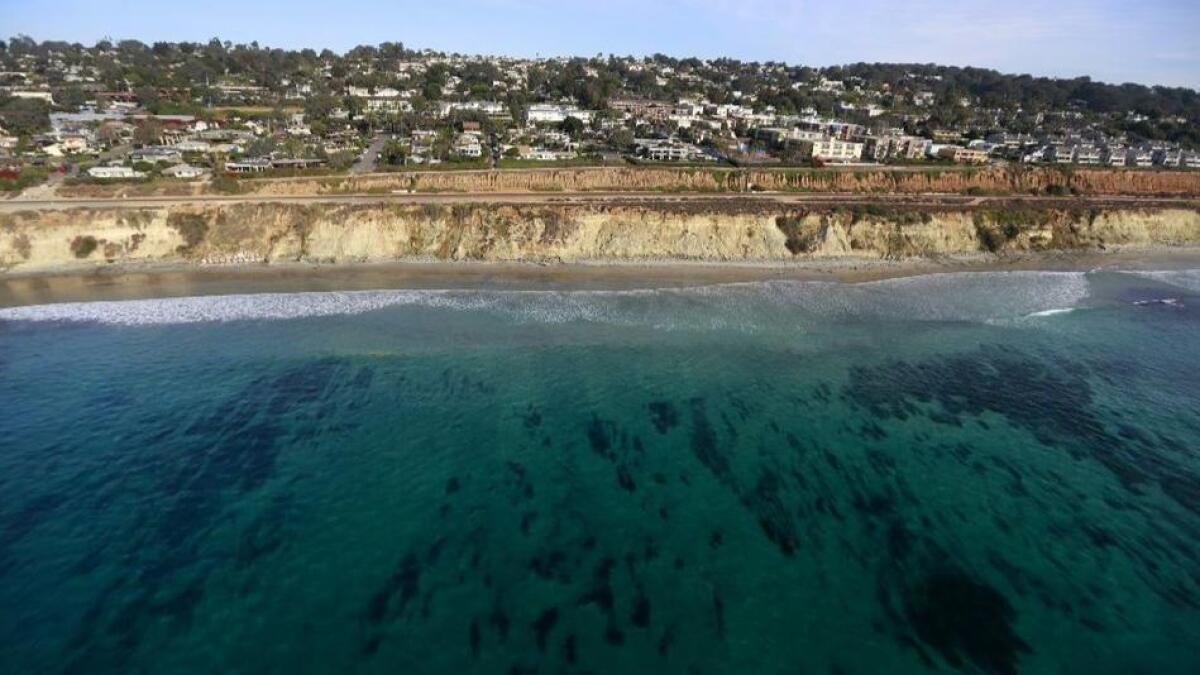How dangerous are the crumbling Del Mar cliffs?

- Share via
Reporting from San Diego — Sections of the cliffs along Del Mar’s coastline have collapsed three times in recent weeks — casting a specter of disaster along the idyllic shoreline.
Fortunately, beachgoers were clear of the landslides each time pieces of the sandstone bluffs came crashing down onto the beach in rolling clouds of dust and heavy debris. One section of rock that broke loose was reportedly 50 feet wide.
“Two of these landslides happened in the middle of the day in areas where people sit regularly,” said Adam Young, a researcher at UC San Diego’s Scripps Institution of Oceanography, who has been tracking cliff erosion in Del Mar and around the state. “It’s lucky nobody was hurt.”
The recent collapses — which occurred on Aug. 22, Sept. 27 and Oct. 5 — happened in areas that Young had previously documented in his work as highly hazardous.
However, the rapid succession of collapses along the seaside cliffs between 11th and 8th streets, was somewhat surprising for the research expert.
“It’s pretty unusual to have three large landslides in such a small area in such a short amount of time,” Young said. “But basically all the cliffs are dangerous places and they all have their day.”
The incidents prompted train service to be temporarily halted along the tracks perched atop the bluffs.
Officials said the last time trains were delayed due to a cliff failure in Del Mar was July 2016.
Passengers riding the Coaster or Amtrak trains that use the rail corridor face no imminent danger from the crumbling bluffs, said Stephen Fordham, director of rail engineering for the North County Transit District.
“The train is safe,” Fordham said. “We inspect the tracks weekly.
“Should there be at any time an act-of-God bluff collapse or earthquake, we’d go in and inspect the tracks and determine whether we should continue train operations,” he said.
Such collapses, accelerated by sea-level rise, also illustrate the potential costs of climate change, regional officials say.
Pounding waves could eventually cause so much damage to the cliffs that sections of the track would need to be relocated at a cost of as much as $3.5 billion, according to the officials.
Rising tides in Del Mar could also force oceanfront homeowners to relocate or risk routine flooding in coming decades.
Homeowners have adamantly rejected any plans to retreat from the shoreline. This month the city insisted that it would build seawalls and regularly replenish beaches before it would ever consider drafting plans to relocate the city’s opulent seaside housing stock.
At the same time, city leaders have expressed some alarm about the recent collapses.
“I think we are all very concerned with the stability of the Del Mar bluffs,” said City Councilman Terry Sinnott, who also serves as the board chair of the region’s premier planning and transportation agency, the San Diego Assn. of Governments. “The three recent collapses at the bluff edges show how fragile they are.”
Other efforts to stave off cliff erosion include planned improvements to stormwater drainage that services nearby communities. Runoff from homes has repeatedly saturated sections of the bluff, adding to the instability.
“You have waves eroding the bottom of the cliffs and groundwater conditions that can add weight to the cliff and lubricate a landslide,” said Young with the Scripps Institution of Oceanography. “In the long term, something is going to have to be done, either moving the train or stopping the waves from hitting the cliffs.”
In the last 20 years, the North County Transit District and the San Diego Assn. of Governments have spent about $5 million to stabilize the bluffs. Dozens of concrete columns two to three feet in diameter have been installed to buttress the train tracks. Millions more are being earmarked for similar projects in the future.
Smith writes for the San Diego Union-Tribune.
More to Read
Sign up for Essential California
The most important California stories and recommendations in your inbox every morning.
You may occasionally receive promotional content from the Los Angeles Times.










